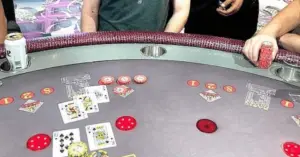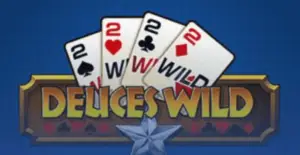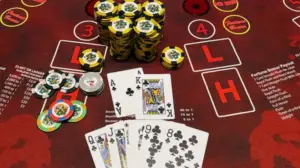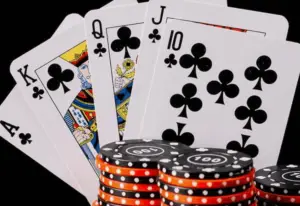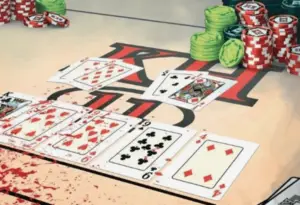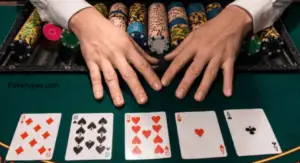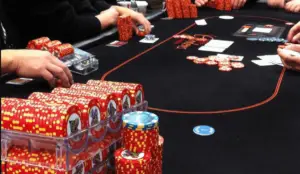Omaha Hi-Lo poker is a variation of the popular card game Omaha. Unlike Texas Hold’em, where you’re dealt two hole cards, in Omaha Hi-Lo, you get four hole cards to work with.
But here’s the twist – you must use exactly two of your hole cards and three community cards to make your hand.
What makes Omaha Hi-Lo unique is the split pot feature. The pot is divided between the best high hand and the best low hand, giving players more ways to win. To qualify for the low hand, all cards must be ranked eight or lower.
This rule adds an extra layer of strategy to the game. Compared to Pot Limit Omaha, where only the high hand wins, Omaha Hi-Lo offers more opportunities to scoop the pot.
It’s a game of nut hands, so players need to be sharp in reading the board and figuring out the best possible hands.
With four betting rounds and the potential for big pots, Omaha Hi-Lo is a fast-paced and exciting game. It’s no wonder that many poker enthusiasts consider it one of the most challenging and rewarding variants out there.
For both seasoned pros and beginners, Omaha Hi-Lo offers a unique poker experience unlike anything you’ve ever experienced.
Omaha Hi-Lo Rules
Let’s break down the rules so you can jump in and play! First off, each player gets four hole cards instead of the usual two.
This gives you more options to make hands, but don’t get too excited – there’s a catch. You must use exactly two of your hole cards and three community cards to make your hand. No more, no less.
Now, here’s where it gets really interesting. Omaha Hi-Lo is a split pot game. This means the pot is divided between the best high hand and the best low hand.
But not just any low hand will do. To qualify for the low, all your cards must be 8 or lower, and aces count as low.
This is why you’ll often hear it called “Omaha 8 or Better“. The betting action happens in four rounds, just like in Texas Hold’em.
You’ve got the preflop, flop, turn, and river. Depending on where you’re playing, you might encounter different betting structures. The most common are fixed limit, pot limit, and sometimes no limit.
Here’s a pro tip: in Omaha Hi-Lo, you’re always gunning for the nut hands. That means the best possible high and the best possible low.
If you can snag both, you’ve just scooped the pot – that’s when you win the whole shebang instead of splitting it.
Remember, Omaha Hi-Lo is all about reading the board and figuring out the best hands quickly.
How to Play Omaha Hi-Lo?
So now that we have a clear understanding of the rules, let’s learn how to play Omaha Hi-Lo! First up, let’s talk about the blinds and deal. Just like in Texas Hold’em, you’ve got a small blind and a big blind.
These are forced bets that get the action going. The dealer then gives each player four hole cards.
That’s right, four! But don’t get too excited – you can only use two of them to make your final hand. Now, let’s break down the betting rounds. There are four of ’em, and they go like this:
Pre-flop: After you get your hole cards, it’s time to decide if you wanna play. You can call, raise, or fold.
Flop: The dealer puts out three community cards on the table. Another round of betting happens.
Turn: A fourth community card hits the table. More betting follows.
River: The last community card is dealt. Final bets are made.
Each round, you’re trying to figure out if you’ve got a shot at the high hand, the low hand, or both! Now, here’s where it gets really interesting – the showdown. Players reveal their hands, and we figure out who wins what.
Remember, in Omaha Hi-Lo, the pot is split 50/50 between the best high hand and the best low hand. For the high hand, it’s just like regular poker.
Royal flush beats a straight flush, which beats four of a kind, and so on. But here’s the kicker – you must use exactly two of your hole cards and three community cards.
The low hand is where things get tricky. To qualify for low, all five cards in your hand must be 8 or lower, and aces count as low.
The best low hand is A-2-3-4-5, also known as the “wheel“.Here’s a pro tip: If there’s no qualifying low hand, the high hand takes the whole pot. This is called “scooping“, and it’s every player’s dream!
Let’s say the final board is A♠ 7♣ 4♦ K♥ 2♠. Player A has A♥ A♣ 3♠ 5♦ and Player B has K♠ K♣ 6♥ 8♦. Player A wins both high (three aces) and low (A-2-3-4-5), scooping the entire pot!
It’s a game of reading the board and quick thinking. With practice, you’ll be splitting pots and scooping like a pro in no time!
So there you have it – that’s how you play Omaha Hi-Lo. It’s a game that’ll keep you guessing and give you twice the chance to win. Why not give it a shot at your next poker night?
Hand Rankings in Omaha Hi-Lo
Let’s examine hand rankings in Omaha Hi-Lo. It’s like playing two games in one, so you’ve gotta keep your eyes peeled for both high and low hands!
For the high hand, it’s business as usual. The rankings are the same as in traditional poker. The royal flush is the king of the hill, followed by a straight flush, four of a kind, and so on down to the high card.
Easy peasy, right? Now, here’s where it gets interesting – the low hand. In Omaha Hi-Lo, we use A-5 lowball rules. This means aces are low, and straights and flushes don’t count against you. Cool, huh?
The best possible low hand is what poker pros call the “wheel” or “bicycle“. That’s 5-4-3-2-A. It’s the nuts for low, so if you’ve got it, you’re sitting pretty. On the flip side, the worst qualifying low hand is 8-7-6-5-4.
Remember, to qualify for low, all your cards must be 8 or lower. If there’s no qualifying low hand, the high hand scoops the whole pot!
In Omaha Hi-Lo, you’re always gunning for the nut low. That’s the best possible low hand given the board. For example, if the board is 2-4-7-9-K, the nut low would be A-3.
Remember, in Omaha Hi-Lo, you’re playing for both high and low. The best starting hands, as A-A-2-3 double-suited, give you a shot at both. It’s all about flexibility and reading the board
Best Omaha Hi-Lo Starting Hands
When it comes to Omaha Hi-Lo, having the right starting hands can make or break your game. Let’s dive into the cream of the crop!
The premium starting hands in Omaha Hi-Lo are like gold. You’ve got your A-A-2-x and A-A-3-x combos, which are super strong because they give you a shot at both the high and low pots.
But don’t sleep on hands like A-2-3-x or A-2-4-x either – they’re sneaky good! Now, if you want the top 10 starting hands that’ll give you the best chance of winning, here’s what you’re looking for:
A-A-2-3 double suited
A-A-2-4 double suited
A-A-2-3 single suited
A-A-2-5 double suited
A-A-2-4 single suited
A-A-3-4 double suited
A-A-2-3 non-suited
A-A-2-2 double suited
A-A-3-5 double suited
A-A-2-6 double suited
See a pattern? Aces and low cards are your best friends in this game!Now, let’s talk about why suited cards are so important.
When you’ve got suited cards, you’re giving yourself a shot at making a flush, which can be a real game-changer. And don’t forget about kicker strength – having a strong kicker can be the difference between winning and splitting a pot.
Omaha Hi-Lo vs. Omaha High
Let’s compare Omaha Hi-Lo with regular Omaha High and see how it stacks up. These games might look similar at first glance, but they’ve got some key differences that’ll keep you on your toes! The biggest difference?
In Omaha Hi-Lo, you’re playing for two pots instead of one. Half the pot goes to the best high hand, and half goes to the best low hand.
This split-pot action makes the game way more exciting! In Omaha High, you’re just gunning for the best high hand. But in Hi-Lo, you’ve gotta think about both high and low.
This means your starting hand selection is super important. You want cards that can win both ways, like A-2-3-4.
Here’s a cool stat: In Omaha Hi-Lo, about 60% of hands end up being split pots. That means you’re often sharing the winnings, which can lead to some wild swings in your stack!
Another big difference is the importance of low cards. In Omaha High, low cards are often junk.
But in Hi-Lo, they’re gold! An ace is especially valuable because it can be used for both high and low hands.Remember, in Hi-Lo, you’re always trying to scoop the pot – that means winning both high and low.
It is not easy, but when it happens, it’s like hitting the jackpot! One last tip: In Hi-Lo, position is even more important than in regular Omaha. Being last to act gives you a huge advantage in figuring out if you’re going for high, low, or both.
Omaha Hi-Lo Starting Hands Point System
Omaha Hi-Lo Starting Hands Point System tells you whether you are strong in Omaha Hi-Lo and what you should do next. First, look at your two lowest cards.
They’re the most important in Omaha Hi-Lo. An A-2 combo is the best, giving you a whopping 20 points. An A-3 is next best at 17 points.
The points go down from there, with 4-5 being the lowest at 8 points. Next, check out your other two cards. A 3 is worth 9 points, a 4 gets you 6 points, and a 5 scores 4 points.
Face cards (J, Q, K) are only worth 2 points each. Now, add up all your points. If you’ve got 25 points or more, you’ve got a hand worth calling with.
If you’re sitting pretty with 40 points or more, you can think about raising. And if you’re lucky enough to have 50+ points, you might even consider re-raising! Here’s a cool example:
Let’s say you’ve got A-2-3-K. That’s 20 points for the A-2, 9 points for the 3, and 2 points for the K. Total: 31 points. That’s a hand you can definitely play!
Remember, this system isn’t perfect. It doesn’t account for suited cards or positions, which are also important. But it’s a great starting point, especially for beginners.
So next time you’re playing Omaha Hi-Lo, give this point system a try. It might just help you make better decisions and win more pots!
Omaha Hi-Lo Strategy Tips
Alright, let’s dive into some killer Omaha Hi-Lo strategy tips that’ll help you crush the game!
Position is Key
In Omaha Hi-Lo, the position is like having a superpower. When you’re in a late position, you’ve got a bird’s eye view of what everyone else is doing.
This lets you make smarter decisions about whether to play your hand or fold. Here’s the deal: In an early position, you wanna be picky. Only play premium hands like A-A-2-3 or A-2-3-4 suited.
These hands give you a shot at both the high and low pots. As you move to middle and late positions, you can loosen up a bit and play more hands.
Remember, being last to act is a huge advantage. You can see what everyone else does before you have to make a decision. It’s like having X-ray vision at the poker table!
Pot Control and Hand Selection
In Omaha Hi-Lo, pot control is super important. You don’t wanna go crazy betting with marginal hands. Instead, focus on hand selection and only play hands that have a good chance of winning both the high and low pots.
Here’s a pro tip: Look for hands with A-2 or A-3 combos. These are gold in Omaha Hi-Lo because they give you a shot at the nut low. Pair these with other low cards or big cards like kings or queens, and you’ve got a hand that can win both ways.
But be careful! Just because you’ve got four pretty cards doesn’t mean you should play them. Hands like K-Q-J-10 might look nice, but they’re trouble in Omaha Hi-Lo. They can’t make a low, and they’re often dominated by the high.
Scooping: The Holy Grail
In Omaha Hi-Lo, scooping the pot is like hitting the jackpot. That’s when you win both the high and low halves of the pot.
It’s not easy, but when it happens, it’s awesome!To have a chance at scooping, you need to play hands that can win both ways. That’s why hands with aces and low cards are so valuable.
For example, A-2-3-4 can make both strong high hands (like flushes or straights) and the best possible low hands.
Here’s a cool stat: In Omaha Hi-Lo, about 30% of pots don’t have a qualifying low. That means if you’ve got a strong high hand, you might scoop the whole pot!
Adjusting to Table Dynamics
Every poker table is different, and Omaha Hi-Lo is no exception. You’ve gotta keep your eyes peeled and adjust your strategy based on what’s happening at your table.
If you notice players are super aggressive and raising a lot, you might want to tighten up and wait for premium hands.
On the flip side, if everyone’s playing really tight, you can loosen up and steal more pots. Pay attention to how often the pot is being split versus scooped.
If you see a lot of split pots, it might be worth playing more hands that have a shot at scooping. If scoops are rare, focus on consistently winning half the pot.
Also, watch out for players who only play for the low or only for the high. You can exploit these tendencies by adjusting your own play.
For example, if someone always goes for the low, you can focus more on high hands when they’re in the pot.
Where to Play Online Omaha Hi-Lo?
Now, let’s check out where you can play, how to practice for free, and how it’s different from live games!
Popular Platforms
If you’re looking to play Omaha Hi-Lo online, you’ve got some great options. PokerStars is a big name in the game, offering tons of action in both cash games and tournaments.
888 Poker and Party Poker are also solid choices for Omaha Hi-Lo fans. For U.S. players, Americas Cardroom (ACR) is a top pick. They’ve got games ranging from tiny stakes ($.01/$.02) all the way up to high roller territory ($100/$200).
Free Play Options
Want to practice without risking real money? No sweat! Replay Poker offers free Omaha Hi-Lo games you can play right in your web browser or on your phone. It’s a great way to get the hang of the game before jumping into real money action.
Online vs. Live Play
Playing Omaha Hi-Lo online is a whole different ball game compared to live play. Here’s the scoop:
Speed: Online games are way faster. You’ll see more hands per hour, which means more action and more chances to win (or lose!).
Multi-tabling: Online, you can play multiple tables at once. This can boost your winnings, but it’s also trickier to keep track of everything.
Tells: In live games, you can pick up on physical tells. Online, you’ve gotta rely more on betting patterns and timing tells.
Conclusion
Omaha Hi-Lo is a thrilling poker variant that offers unique challenges and opportunities. We’ve covered the basic rules, hand rankings, and key strategies for success.
Remember, position is crucial, and the best starting hands often include A-2 or A-3 combinations. Always aim to scoop the pot by playing for both high and low hands.
Online platforms like PokerStars and 888 Poker offer great options for playing, while free sites like Replay Poker are perfect for practice.
As with any poker game, success in Omaha Hi-Lo comes with experience. So get out there, hit the tables, and keep refining your skills. With practice and patience, you’ll be splitting pots and scooping like a pro in no time!










